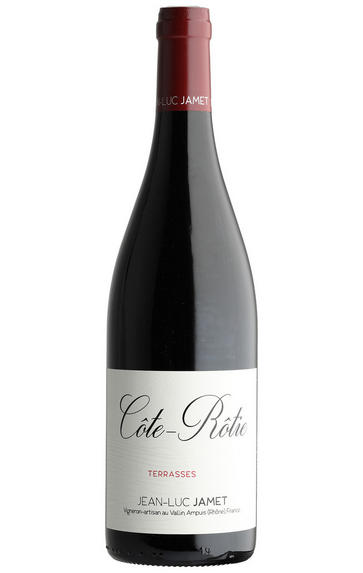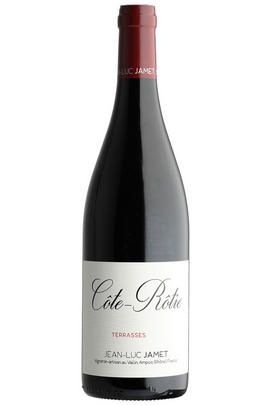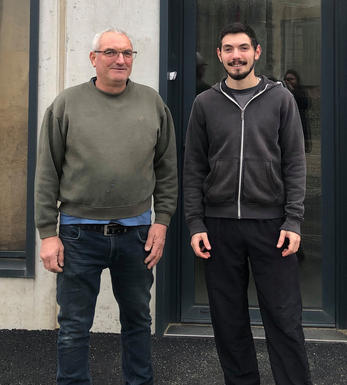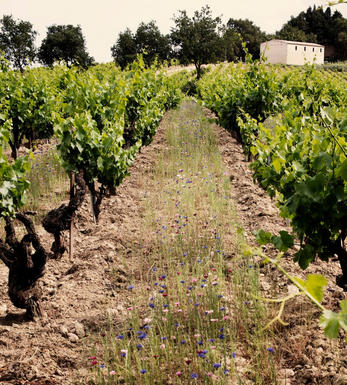
2017 Côte-Rôtie, Terrasses, Jean-Luc Jamet, Rhône

Critics reviews
In contrast to the sullen 2018, Jamet's 2017 Cote Rotie Terrasses is more open at the moment, with attractive notes of strawberry and raspberry compote framed by velvety tannins. It's full-bodied, with enough stuffing to carry it at least another decade, probably longer.
Just a few steps up the hill and a solid stone wall apart from the old family domaine now home to his brother, Jean-Luc Jamet continues to build and expand his brand-new cellars. As it had been some time since my previous visit, we had some catching up to do, and we went through a few short verticals of the domaine's wines, as well as a quick barrel tasting of the lots destined for the 2020 Cote Rotie Terrasses.
Drink 2022 - 2035
Joe Czerwinski, Wine Advocate (January 2022)
About this WINE

Vignoble Jean-Luc Jamet
Jean-Luc Jamet worked for many years alongside his brother Jean-Paul at the family estate, Domaine Jamet, before setting off on his own in 2013. He now works a total of eight hectares with his son, Benoit: five hectares of Côte-Rôtie, two of Côtes-du-Rhône and one hectare of Vin de Pays. Currently undergoing extensive renovations, the estate can be found on the plateau at Le Vallin, an impressively windy drive above the slopes of the Côte Rôtie. His flagship wine is the Côte-Rôtie Terrasses and is receiving increasing interest – though his generic labels should not be over-looked. He is even experimenting with non-Rhône varieties under his IGP labels.
This is the second year running we’ll be offering Jean-Luc’s wines, following on from the success of last year. His 2020 Côte-Rôtie shows the concentration and intensity of this bold but elegant vintage, while his white showcases the acid structure and purity of the 2021s — both with plenty of personality and ageing potential.

Côte-Rôtie
Côte-Rôtie is one of the most famous of the northern Rhône appellations, with some single vineyard cuvées now selling for the same prices as First Growth Bordeaux. It is the northernmost outpost of the Syrah grape.
Côte-Rôtie translates as ‘roasted hillside’, as the south-facing slopes are exposed to the maximum-possible sunlight. Vines have been planted here since Roman times, although the appellation was only created in 1940. Today it covers 500 hectares, with 276 hectares of vineyards stretched across eight kilometres.
Phylloxera devastated vineyards in the late 1800s and Côte-Rôtie’s fortunes remained in the doldrums for another century. After the War, a farmer would receive double the price for a kilo of apricots as for a kilo of grapes, hence vineyards were grubbed up and wine production became increasingly smaller.
It has only really been recognised as a top-quality wine-producing area since the 1970s, with Guigal being the main impetus behind its revival. The two best slopes, Côte Brune and Côte Blonde, rise steeply behind Ampuis and overlook the river. The Côte Brune wines are much firmer and more masculine (the soils are clay and ironstone), whereas the Côte Blonde makes wines with more finesse and elegance due to its light, sandy-limestone soil. Both the Côte Brune and Côte Blonde vineyards rise to 1,000 feet, with a gradient of 30 to 50 degrees.
The wines are made from the Syrah grape, however up to 20 percent of Viogner can be used in the blend, adding finesse, elegance and floral characteristics to the wine. Viognier ripens more quickly than Syrah and the appellation rules stipulate that the grapes must be added to the fermentation – rather than blended later. The best Côte-Rôtie are very deep in colour, tannic and spicy, and need 10 years to evolve and develop.
There are nearly 60 official vineyards (lieux-dits); the best-known are: La Mouline, La Chatillonne (Vidal-Fleury, owned by Guigal) and La Garde (Rostaing) in Côte Blonde; La Viallière, (Rostaing), La Landonne (Guigal, Rostaing) and La Turque (Guigal) in Côte Brune.
Styles vary from heavily-extracted tannic wines which need many years to soften through to lighter, supple and less-structured wines which do not require extended bottle ageing. The most famous wines of Côte-Rôtie are Guigal’s three single-vineyard cuvées: La Mouline, La Turque and La Landonne. These are aged in new wood for 48 months, and demand for them amongst connoisseurs and collectors is significant, leading to prices sometimes comparable to Bordeaux First Growths.
Recommended producers: Guigal, Gerrin, Rostaing, Ogier, Burgaud
Best vintages: 2006, 2005, 2004, 2001, 1999, 1991, 1990, 1985

Syrah/Shiraz
A noble black grape variety grown particularly in the Northern Rhône where it produces the great red wines of Hermitage, Cote Rôtie and Cornas, and in Australia where it produces wines of startling depth and intensity. Reasonably low yields are a crucial factor for quality as is picking at optimum ripeness. Its heartland, Hermitage and Côte Rôtie, consists of 270 hectares of steeply terraced vineyards producing wines that brim with pepper, spices, tar and black treacle when young. After 5-10 years they become smooth and velvety with pronounced fruit characteristics of damsons, raspberries, blackcurrants and loganberries.
It is now grown extensively in the Southern Rhône where it is blended with Grenache and Mourvèdre to produce the great red wines of Châteauneuf du Pape and Gigondas amongst others. Its spiritual home in Australia is the Barossa Valley, where there are plantings dating as far back as 1860. Australian Shiraz tends to be sweeter than its Northern Rhône counterpart and the best examples are redolent of new leather, dark chocolate, liquorice, and prunes and display a blackcurrant lusciousness.
South African producers such as Eben Sadie are now producing world- class Shiraz wines that represent astonishing value for money.


Buying options
Add to wishlist
Description
In contrast to the sullen 2018, Jamet's 2017 Cote Rotie Terrasses is more open at the moment, with attractive notes of strawberry and raspberry compote framed by velvety tannins. It's full-bodied, with enough stuffing to carry it at least another decade, probably longer.
Just a few steps up the hill and a solid stone wall apart from the old family domaine now home to his brother, Jean-Luc Jamet continues to build and expand his brand-new cellars. As it had been some time since my previous visit, we had some catching up to do, and we went through a few short verticals of the domaine's wines, as well as a quick barrel tasting of the lots destined for the 2020 Cote Rotie Terrasses.
Drink 2022 - 2035
Joe Czerwinski, Wine Advocate (January 2022)
wine at a glance
Delivery and quality guarantee